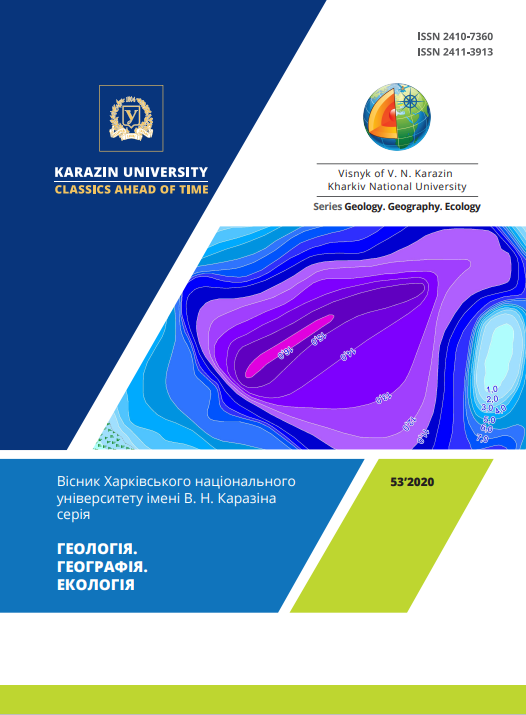Environmental situation of Dnister regional landscape park
Abstract
Formulation of the problem. The Dniester Regional Landscape Park (DRLP) is a natural protected area of Ukraine that extends along the right bank. Dniester, within the Tlumatsky and Gorodenkovsky districts of Ivano-Frankivsk region, covers an area of 19 656 ha. It was founded by the decisions of the Ivano-Frankivsk Regional Council on July 15, 1993 and December 3, 2016, when the park was named after Sergiy Didych. The objectives of the park are: conservation of valuable natural and floristic-cultural complexes; creation of conditions for efficient tourism and recreation; adherence to the regime of protection of protected objects; promotion of ecological and educational work; maintaining an overall environmental balance in the region.
The research methodology performed by the specialists of the Department of Ecology of the Ivano-Frankivsk National Technical University of Oil and Gas was based on a component assessment of the ecological state of the geological environment, relief, water resources, atmospheric air, soil and vegetation, sociosphere and technosphere by selection construction of databases and ecological and technological-geochemical maps of the state of the environment.
As a result of studies of the geological environment, geomorphosphere and soil cover, their changes under the influence of natural (planar, linear and bright erosion, villages, landslides, landslides, landslides, etc.) and technogenic (quarries, drilling wells, etc.) factors are still negligible - from 0.0015 to 0.04% of the area and volume in the model areas. Surface water pollution in the Dniester River and its tributaries is average, and groundwater – from normal to satisfactory. Only in places where the polluted water is discharged is it difficult and unsatisfactory. Ecological condition of atmospheric air, precipitation of rain and snow, vegetation cover – normal and only about mm. Interpreter and Gorodenko – satisfactory and complex. On the whole, according to the assessment of all environmental components, the environment of the DRLP is still in good condition, but requires the implementation of the measures recommended by the authors.
The scientific novelty of the environmental research of the DLRP is that the authors of the article first performed their own field environmental studies on the monitoring system of each component of the landscape, and the results using GIS technologies to build a summary ecological map.
The practical significance of the work is to provide the DPRL with a scientific basis for the creation of a permanent ecological monitoring network and the dissemination of the methods of ecological assessment developed by the authors to other nature reserves and sites - nature monuments, reserves, national nature parks, nature reserves, biosphere reserves and reserves.
Downloads
References
Adamenko, O.M., Zorina, N.O. (2015). Methodology and organization of scientific research in ecology. Ivano-Frankivsk: Suprun, V.P., 172.
Alth, A., Benyash, F. (1887). Geological Atlas of Galicia. Notebook 1. Krakow.
Barbot-de-Marni, N.P. (1967). Report on a trip to Galicia, Volhynia and Podolia in 1865. Jubilee. Sat Mineral. So-ciety, St. Petersburg.
Boguckiy, A.B. Svinko, J.M. (1975). Anthropogenic denudation surfaces of the northern edge of the Podil Upland. Dopovidi AN USSR, 6, Kyiv, 433.
Veklich, M.F. (1965). The main stages of development of river valleys. Kiev, Naukova dumka, 7–26.
Veklich, Yu.M. (2009). Quaternary deposits. State Geological Map of Ukraine. Scale 1: 200 000, sheet M-35-XXV. Explanatory note, 41–56.
Voloshin, I.M. (1998). Landscape-ecological bases of monitoring. Lviv, Space, 336.
Gofstein, I.D. (1962). Neotectonics and morphogenesis of the upper Transnistria. Kyiv, AN USSR, 132.
Ecological encyclopedia in 3 volumes (2007–vol. I, 2008–II,2008–III). Kyiv, I–432, II–416, III–472.
Ecological model of the Dniester (G. Plachter, W.M. Stetsyuk, OM. Adamenko and oth.) (1995). Kyiv, Znannja, 30.
Zorin, D.O. (2016). Geographical information systems of ecological safety: textbook. Ivano-Frankivsk, Suprun, V.P., 180.
Kravchuk, Ya.S. (1999). Geomorphology of Precarpathia. Lviv, Mercator, 188.
Lungershausen G.F. (1941). Geological evolution of Podillya and Southern Transnistria. Kyiv, AN USSR, 9-90.
Palienko, V.P. (1974). On the types of Holocene alluvium of the Dniester valley. Materials on the Quaternary peri-od of Ukraine. Kyiv, Naukova dymka, 247-250.
Polyansky, Yu.I. (1929). Podil etudes: terraces, forests and morphology of the Galician Podillya on the Dniester. Collection of mathematical-natural-medical section of NTSh. Lviv, 20, 191.
Trofimchuk, O.M., Adamenko, O.M., Trisnjuk, V.M. (2020). Geoinformation technologies for environmental protec-tion of the nature reserve fund. Ivano-Frankivsk-Kiiv, Suprun V.P., 340.
Tsarik, L.P. (2006). Ecological-geographical analysis and assessment of territories: theory and practice (on the materials of Ternopil region). Ternopil, Bogdan, 256.
Alth, A., Bieniasz, D. (1887). Atlas geologiczny Galicyi. Text do resz. 1. Wyd. Kom. Fisiogr. Pol. Akad. Um. Kraków.
Boguckyi, A. Lanczont, M. (2002). Stratygrafia lessow Naddniestrza halickiego. Lessy І paleolit Naddniestrza halickiego (Ukraina). Studia geologica Polonica (Pod red. T. Madeyskiej). Kraków, 119, III, 315-341.
Czyzewski J. (1928). Z historij doliny Dniestry: Pr. Geogr., 10. Lwów-Warszawa, 33-62.
Lanczont, M., Bogutskyj, A., Racinowski, R., Seul, C., Wojtanowicz, J. (2003). Eopleistocene and Lower Mesopleistocene paleosols in the Zahvizdja profile in the East Carpathian Foreland (W. Ukraine). Quaternary International, 106-107: 119-130.
Madeyska, T. (2001). Porownanie stratygrafii jaskiniowych i lessowych stanowisk paleolitycƶnych Iury Polskiey i Ƶachodneij Ukrainy. Ƶ Archcologii Ukrainy j Iury Ojcowskiej: 415-432.
Szajnocha, W. (1892). Wosk ziemnz w Galicyi. Przewodnik Naukowo-Literacki, 82: 177-187; 90: 266-283.
Yatsyshyn, A., Dmytruk, R. (2003). Surface loess-soil complexes of Dniester’s terraces: Loes and Paleoenvironment. Abstracts and Field Excursion Guidebook. Moskow, May 2–June 1, 63-64.





